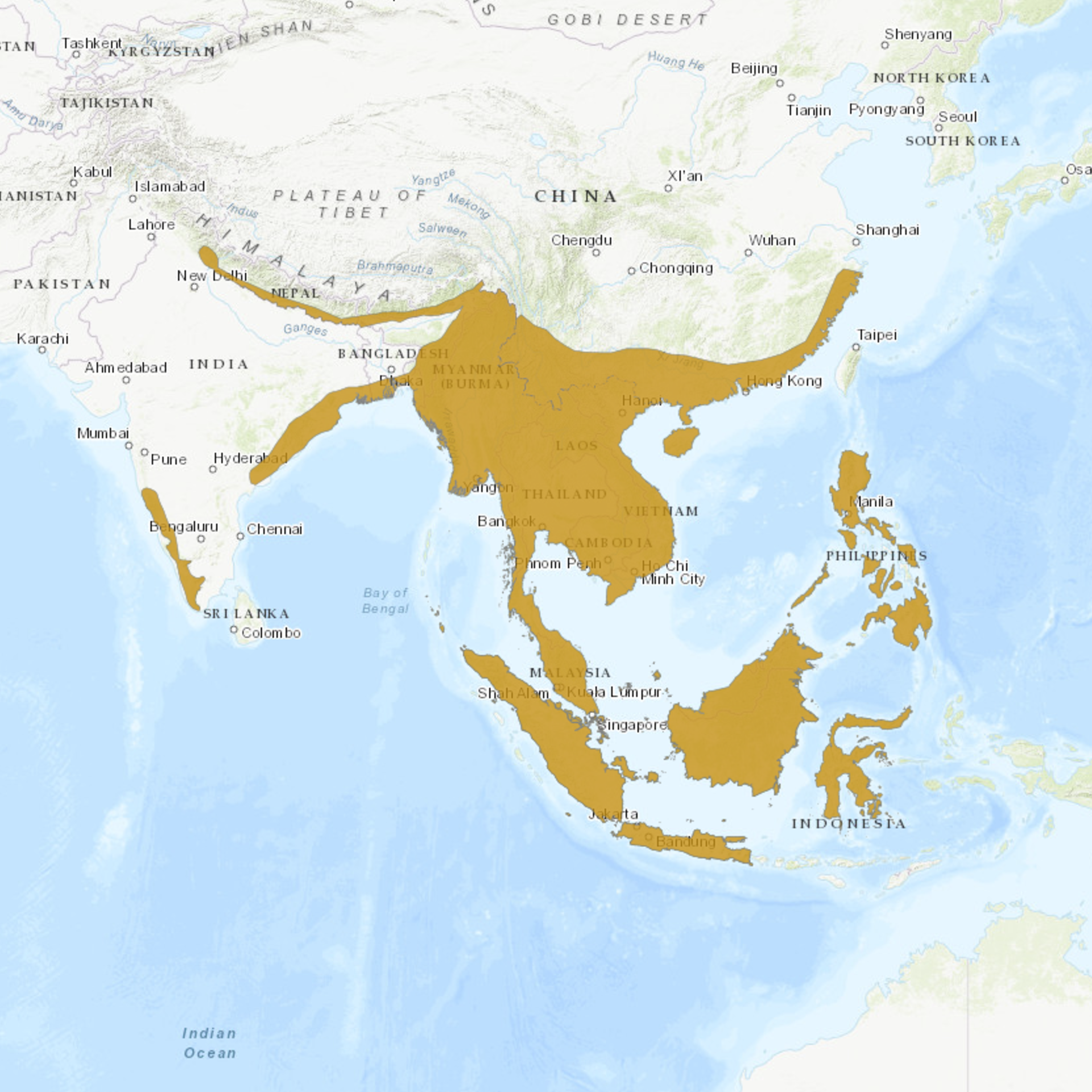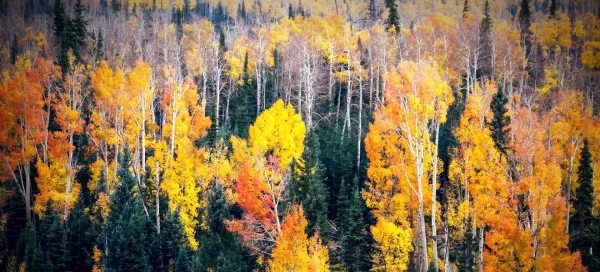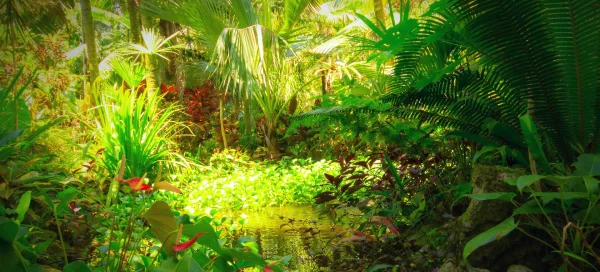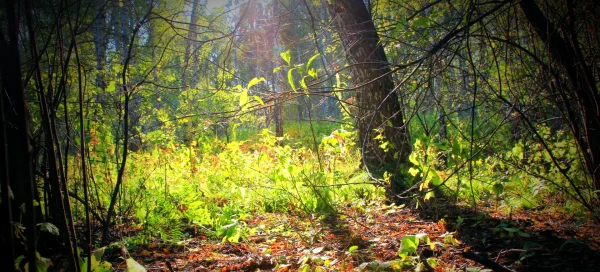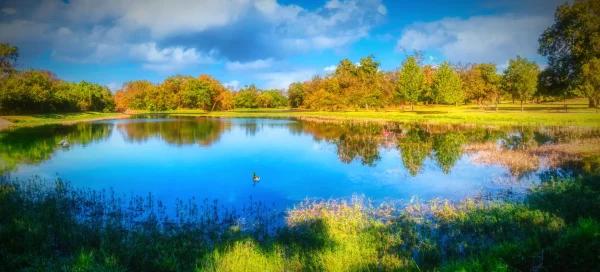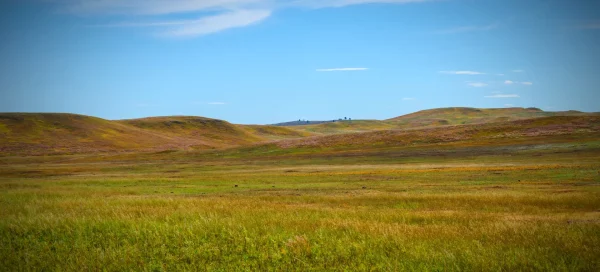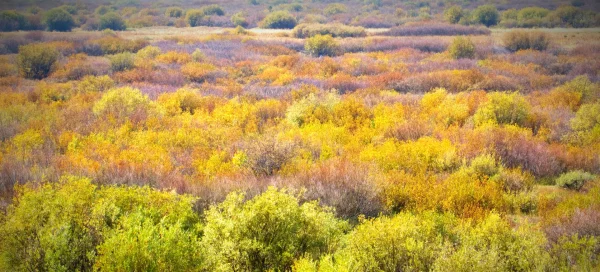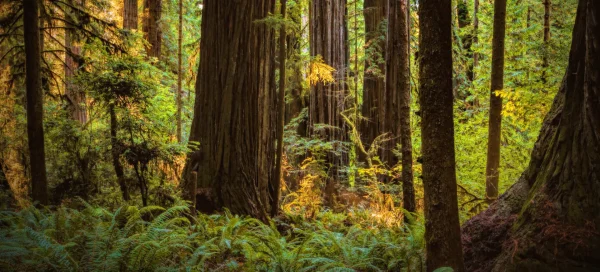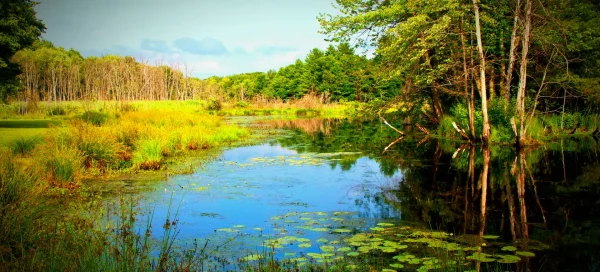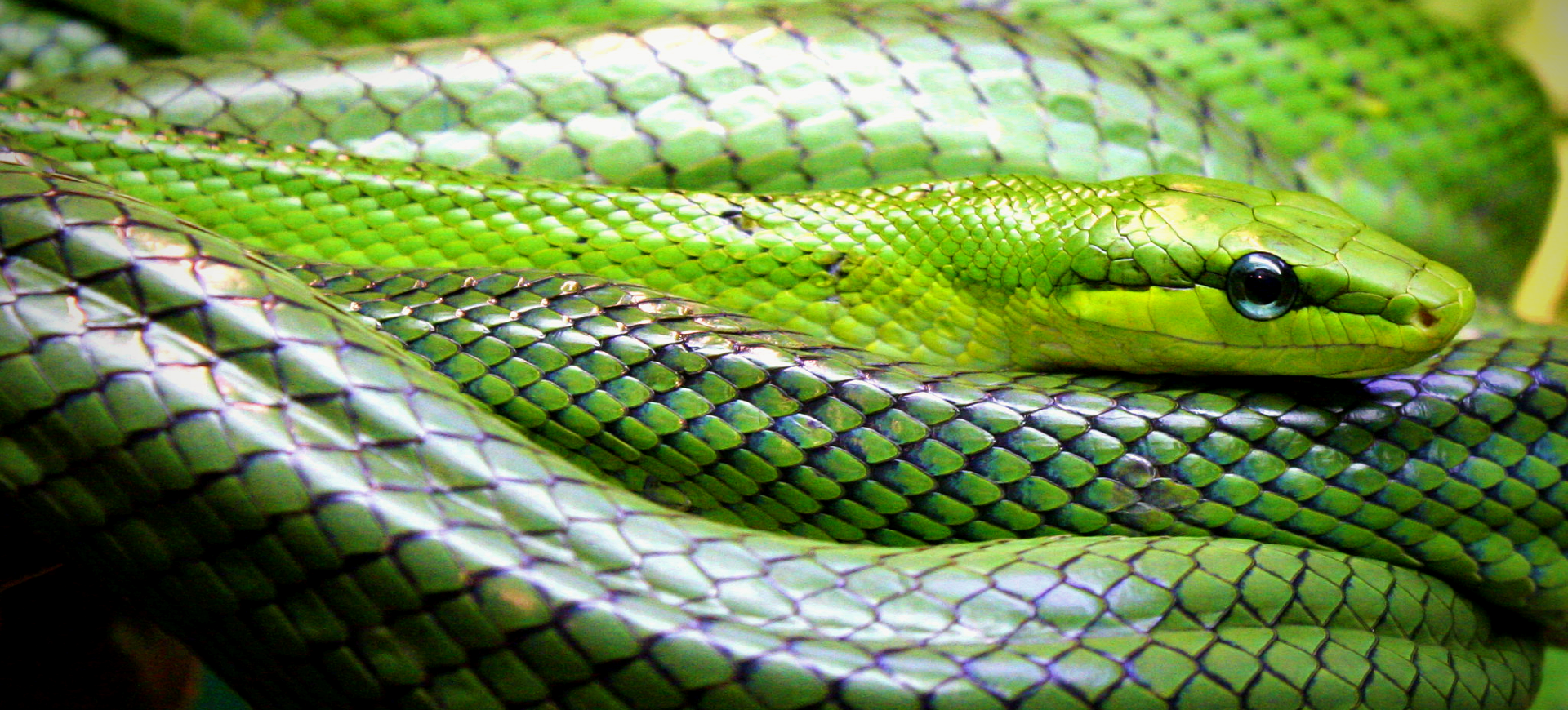Overview
The King Cobra is the longest venomous snake in the world, capable of reaching lengths over 18 feet (5.5 meters), and is native to forests across South and Southeast Asia. Unlike most other cobras, it primarily preys on other snakes, including both venomous and non-venomous species, as well as occasionally on lizards and small mammals. This species is highly intelligent and can recognize handlers, display complex defensive behaviors, and produce a deep, resonant growl when threatened. King Cobras are revered and feared throughout their range, where they play a crucial role as apex predators in their ecosystems.
They inhabit dense highland and lowland forests, bamboo thickets, mangrove swamps, and agricultural areas near water sources. During the breeding season, females build nests out of leaf litter—unique among snakes—and remain to guard their eggs aggressively until hatching. Despite their notoriety, King Cobras are generally shy and avoid humans, preferring to retreat when possible. However, when cornered, they can rear up to a third of their body length and flare their distinctive hood in a powerful threat display.
Their venom is primarily neurotoxic, capable of killing an adult human in under an hour by causing respiratory failure. Bites are rare, as King Cobras typically flee from disturbance, but they are responsible for serious envenomations among snake handlers and in rural communities. Populations are declining due to habitat destruction, persecution, and collection for the skin and pet trades. Conservation efforts emphasize habitat protection, anti-poaching enforcement, and education to reduce fear-based killings.
Taxonomy
Kingdom
Phylum
Class
Order
Family
Genus
Species
Type
Current distribution:
King Cobras have a broad but fragmented distribution across South and Southeast Asia. Populations remain most robust in protected reserves and remote forests of Northeast India, Myanmar, and Thailand. In the Western Ghats and parts of Indochina, densities have declined due to deforestation and poaching. In Indonesia and Malaysia, they persist in lowland rainforests and plantations but face increasing habitat encroachment.
Local extirpation has occurred near urban centers where persecution is frequent. Their secretive habits and large home ranges make it difficult to obtain precise population estimates. Despite a widespread range, population connectivity is increasingly compromised by habitat fragmentation. Ongoing monitoring indicates significant declines in many regions.
Physical Description:
The King Cobra has a long, slender body with smooth, olive, tan, or black scales, and pale yellow crossbands running the length of its body. Its head is broad and flattened, distinct from the neck, and features large scales on the crown. The hood is narrower and longer than that of true cobras, and when spread, it reveals a spectacle-like pattern on the neck. The eyes are large with round pupils, providing excellent binocular vision crucial for hunting other snakes.
Juveniles are glossy black with striking white or yellow bands, gradually changing to adult coloration as they mature. The tail tapers to a fine point, and the ventral scales are broad, aiding in locomotion. The fangs are relatively short compared to those of a viper, but they are fixed at the front of the jaw, allowing for efficient venom delivery. Adult males are typically larger than females, although females tend to be more robust in build.

Lifespan: Wild: ~20 Years || Captivity: ~25 Years

Weight: Male: 13–20 lbs (6–9 kg) || Female: 11–15 lbs (5–7 kg)

Length: Male: 144–216 in (366–549 cm) || Female: 120–180 in (305–457 cm)

Height: Male: 10–12 in (25–30 cm) (body height when on ground) || Female: 8–10 in (20–25 cm) (body height when on ground)

Top Speed: 12 mph (19 km/h)
Characteristic:
Native Habitat:
King Cobras inhabit tropical and subtropical forests, bamboo thickets, mangrove swamps, and areas near streams and rivers across India, Bangladesh, Myanmar, Thailand, Laos, Cambodia, Vietnam, Malaysia, Indonesia, southern China, and the Philippines. They prefer habitats with dense ground cover and abundant prey availability. Riparian zones are particularly important for thermoregulation and hydration. The presence of termite mounds, hollow logs, and thick leaf litter offers shelter and nesting sites.
They can tolerate disturbed habitats, including agricultural edges and plantations, if adequate cover and prey are present. Seasonal activity patterns are influenced by rainfall, temperature, and the abundance of prey. They are mostly diurnal but may hunt at dusk during the hot season. Habitat loss due to logging, agriculture, and urbanization is a significant threat across much of their range.
Biogeographical Realms:
Continents:
Diet:
Diet & Feeding Habits:
King Cobras are obligate ophiophages, meaning their diet consists primarily of other snakes, including rat snakes, pythons, and various venomous species such as kraits and other cobras. They are active hunters, utilizing their keen eyesight and forked tongue to track the chemical trails left by their prey. Upon locating a target, they deliver a rapid bite and hold on until the prey succumbs to neurotoxins. After envenomation, the snake swallows the prey whole, starting from the head.
In addition to snakes, King Cobras occasionally eat monitor lizards and rarely rodents if snake prey is scarce. Adults feed infrequently, consuming large meals that sustain them for weeks or even months. They play a crucial ecological role by regulating snake populations in their habitats. Juveniles are more opportunistic and may target smaller lizards and amphibians during early growth stages.
Mating Behavior:
Mating Description:
King Cobras are generally solitary but come together during the breeding season, which typically occurs from January to April. Males engage in combat rituals, wrestling and attempting to pin each other to the ground to secure access to receptive females. Courtship involves tongue-flicking, body alignment, and tactile stimulation before copulation. Females are unique among snakes in that they build and guard a nest constructed from leaf litter and debris.
Egg-laying occurs several weeks after mating, with females depositing 20–50 eggs in the carefully built mound. The female remains to guard the nest aggressively until hatching, sometimes for over two months. Incubation lasts 60–90 days, after which hatchlings emerge fully independent and highly venomous. The female leaves the area shortly before the eggs hatch to avoid potential cannibalism.
Reproduction Season:
Birth Type:
Pregnancy Duration:
Female Name:
Male Name:
Baby Name:
Social Structure Description:
King Cobras are solitary animals except during the breeding season or when encountering conspecifics during territorial disputes. Home ranges are large, with males roaming extensively in search of mates. Territorial interactions between males can involve prolonged combat displays. Communication is primarily chemical, utilizing pheromones to identify reproductive status and mark territory boundaries.
Females display unusual parental care, remaining near nests and defending eggs until hatching. Hatchlings are independent immediately upon emergence. Adults avoid each other outside of breeding, reducing competition and the risk of injury. Their solitary nature contributes to low population density even in optimal habitats.
Groups:
Conservation Status:
Population Trend:
King Cobra populations are declining in most parts of their range due to habitat destruction, direct persecution, and overexploitation for skin and traditional medicine. In India and Southeast Asia, the fragmentation of forest habitats has isolated populations and reduced prey availability. Local extirpations have been recorded near expanding agricultural frontiers. Protected areas harbor more stable populations but remain vulnerable to poaching and accidental killings.
Captive populations are maintained widely for education, research, and conservation breeding. However, breeding success varies, and reintroduction programs are limited. Genetic diversity in fragmented wild populations is a growing concern. Continued habitat loss and persecution threaten to accelerate declines unless intervention occurs.
Population Threats:
Habitat loss due to deforestation, logging, and agricultural expansion is the most significant threat to the species across its range. Persecution by humans due to fear and snakebites contributes heavily to mortality. Collection for the exotic pet trade, traditional medicine, and leather products further reduces wild numbers. Road mortality is common in areas where roads bisect suitable habitat.
Declines in prey populations, particularly those of other snakes, also impact survival. Climate change may impact reproduction and prey availability by altering seasonal cycles. Education and improved coexistence strategies are needed to reduce fear-based killing. Ongoing habitat fragmentation exacerbates all other threats.
Conservation Efforts:
King Cobras are legally protected in much of their range, including India and Thailand, where killing or capturing them without a permit is prohibited. Habitat conservation efforts focus on preserving contiguous tracts of forest and riparian corridors. Rescue and translocation programs are used to relocate individuals from human settlements. Research on reproduction and genetics informs captive breeding and potential reintroduction efforts.
Public education campaigns aim to reduce fear and promote coexistence through safe snake handling practices. Anti-poaching patrols and stricter enforcement of wildlife trade laws help curb the illegal collection of wildlife. Community-based conservation initiatives engage local people in protecting forest habitats. International collaboration supports research and conservation funding.
Additional Resources:
Fun Facts
- King Cobras can rear up over 5 feet off the ground when threatened.
- They produce a deep growl or hiss that is much lower in pitch than other snakes.
- Their scientific name, Ophiophagus hannah, means “snake-eater.”
- They are the only snakes to build and guard a nest.
- Hatchlings are fully venomous from birth.
- A single bite can deliver enough venom to kill an elephant.
- They have excellent vision and can detect movement nearly 300 feet away.
- In captivity, they can live more than two decades.
- King Cobras are revered in Hindu mythology as Nagas.
- Despite their size and power, they are shy and prefer to avoid humans.


